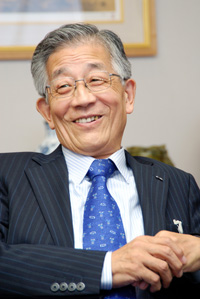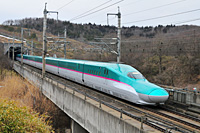Tokyo Tech News
Tokyo Tech News
Published: July 31, 2010
A Tokyo Institute of Technology (Tokodai) OB shares some memories of his student days and gives us a behind-the-scenes look at running the largest railway company in the world, including the super-fast ‘Shinkansen’ railway network.
Yoshio Ishida is Vice Chairman of the East Japan Railway Company (JR-East) — one of the largest railway companies in the world. Ishida joined the Japan Railways — the state-run predecessor of the now privately run JR-East — in 1967 after graduating from Tokyo Institute of Technology or Tokodai.
“As a student I was a member of the boat club at Tokodai,” says Ishida. “I have some very fond memories of taking part in intercollegiate races and other activities organized by the club. The club also was a place where I made some very good friends. ”
Ishida has great expectations of Tokodai in the 21st century. “I think Professor Iga, the president of Tokodai, has initiated a wide range of highly innovative and imaginative projects that build on the more than 100-year history of the university, for a dynamic and globally visible research-orientated university.”
Ishida adds that the introduction of some liberal arts courses may enhance and compliment the science- and engineering-based Tokodai curricula at the moment. “We are living in a much more diverse society than in my university days,” says Ishida. “Graduates with diverse experience are becoming more valuable as leaders of modern industry.”
Visitors to Japan often marvel at the punctuality and safety of the trains. What is the reason for this? “Some may say that Japan’s trains are too punctual and ‘abnormal’,” says a smiling Ishida. “I think the answer to this question is that in Japan people working on the railway system have a flexible approach towards their work, and do not just work based on a manual. For example, the staff responsible for cleaning the Shinkansen carriages do not know beforehand how much effort will be necessary to clean a particular carriage. They improvise and work together to get the job done on time. The people who work on the railway system are the key to trains being on time and safe; it’s not just the technology. ”
On a global scale, history shows that railways have been a vital means of transport for millions of people worldwide for more than a century. Notably, in the early 1920s there was strong interest in Europe for the creation of an international organization to oversee the construction and operations of railways. Several rounds of conferences eventually led to the establishment of the International Union of Railways (UIC) in 1922, initially with 51 members from 29 countries. Now, the UIC has 196 members from five continents with aims including the promotion of benchmarking, business development, interoperability, standardization, and so on.
In April 2009, Ishida was elected chairman of UIC. “This position is both an honour and a challenge,” says Ishida. “I have made several new suggestions such as organizing conferences centered on presentations by specialists, followed by networking.”
Ishida is also the chairman of The International Railway Research Board (IRRB) — a UIC initiative to develop ‘synergies’ in research on railways.
“The IRRB is an excellent place to discuss many of the important issues facing railways worldwide,” says Ishida. “It’s a forum to exchange ideas. Our next meeting is in St Petersburg.”
Global trends show an increasing awareness of the fact that railways offer an ‘eco-friendly’ means of transportation, for both passengers and freight. “The railway industry still has many challenges to face in the future,” says Ishida. “For example, I think we still need to work harder to improve the efficiency of power systems for running electric trains. Such technology would indeed make trains ‘eco-friendly’.”
Japan is renowned for the high speed Shinkansen or bullet-train system, where even the earliest ‘0 series’ introduced in 1964 operated at a maximum operating speed of 220 km/h. Recently, JR-East announced plans to introduce the ‘E5 series’ from Tokyo to Shin-Aomori starting in March 2011. The E5 is capable of an amazing maximum speed of 320 km/h, although the carriages will initially run at 300 km/h.
But what limits the speed of trains? “Japan’s engineers have produced extremely fast trains, like the ‘E5’ series,” says Ishida. “One of the main hurdles for speeds above 320 km/h is noise due to air-compression when a train enters a tunnel. We have used super computers to study the aerodynamics of trains entering tunnels and at the moment we think that noise in tunnels will limit the maximum to about 360 km/h.”
But Ishida and his colleagues at JR-East are still conducting research on high speed trains, “because we learn a lot from such projects,” according to Ishida. “We often find unexpected and important phenomena for the railway systems of the future.”

Yoshio Ishida, Vice Chairman of the East Japan Railway Company

Series E5 Prototype Shinkansen
Reference
Yoshio Ishida
Center for Public Information
Other